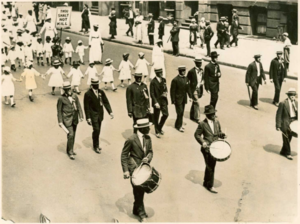| Anti-lynching movement | |
|---|---|
| Part of the nadir of American race relations | |
 Marchers in the Silent Parade. | |
| Date | 1890s-1930s (height) |
| Location | |
| Caused by | Lynching in the United States |
| Goals |
|
| Methods |
|
| Part of a series on the |
| Nadir of American race relations |
|---|
 |
The anti-lynching movement was an organized political movement in the United States that aimed to eradicate the practice of lynching. Lynching was used as a tool to repress African Americans.[1] The anti-lynching movement reached its height between the 1890s and 1930s. The first recorded lynching in the United States was in 1835 in St. Louis, when an accused killer of a deputy sheriff was captured while being taken to jail. The black man named Macintosh was chained to a tree and burned to death. The movement was composed mainly of African Americans who tried to persuade politicians to put an end to the practice, but after the failure of this strategy, they pushed for anti-lynching legislation. African-American women helped in the formation of the movement,[2] and a large part of the movement was composed of women's organizations.[3]
The first anti-lynching movement was characterized by black conventions, which were organized in the immediate aftermath of individual incidents. The movement gained wider national support in the 1890s. During this period, two organizations spearheaded the movement—the Afro-American League (AAL) and the National Equal Rights Council (NERC).[3]
The first anti-lynching bill was the Dyer Anti-Lynching Bill introduced in the 65th United States Congress by Representative Leonidas C. Dyer, a Republican from St. Louis, Missouri. The Dyer bill was re-introduced in subsequent sessions of Congress, but its passage was blocked in the Senate by a filibuster by Southern Democrats, and was never enacted. On January 4, 1935, Democratic Senators Edward P. Costigan and Robert F. Wagner together set out a new bill, the Costigan-Wagner Bill, that stated: "To assure to persons within the jurisdiction of every state the equal protection of the crime of lynching." The bill had many protections from all types of lynching.[4] In March 2022, the Emmett Till Antilynching Act, banning the practice and classifying it as a hate crime, passed both houses of Congress and was signed into law by President Joe Biden on March 29, 2022.
- ^ Cedric J. Robinson (February 20, 1997). Black Movements in America. Psychology Press. p. 105. ISBN 978-0-415-91222-8. Retrieved April 12, 2012.
- ^ Lynne E. Ford (2008). Encyclopedia of Women and American Politics. Infobase Publishing. p. 37. ISBN 978-1-4381-1032-5. Retrieved April 12, 2012.
- ^ a b Paul Finkelman (November 2007). Encyclopedia of African American History, 1896 to the Present: From the Age of Segregation to the Twenty-First Century. Oxford University Press. pp. 78–82. ISBN 978-0-19-516779-5. Retrieved April 12, 2012.
- ^ Walter, David O. (June–July 1935). "Previous Attempts to Pass a Federal Anti-Lynching Law". Congressional Digest. 14 (6/7): 169–171 – via EBSCOhost.[permanent dead link]
